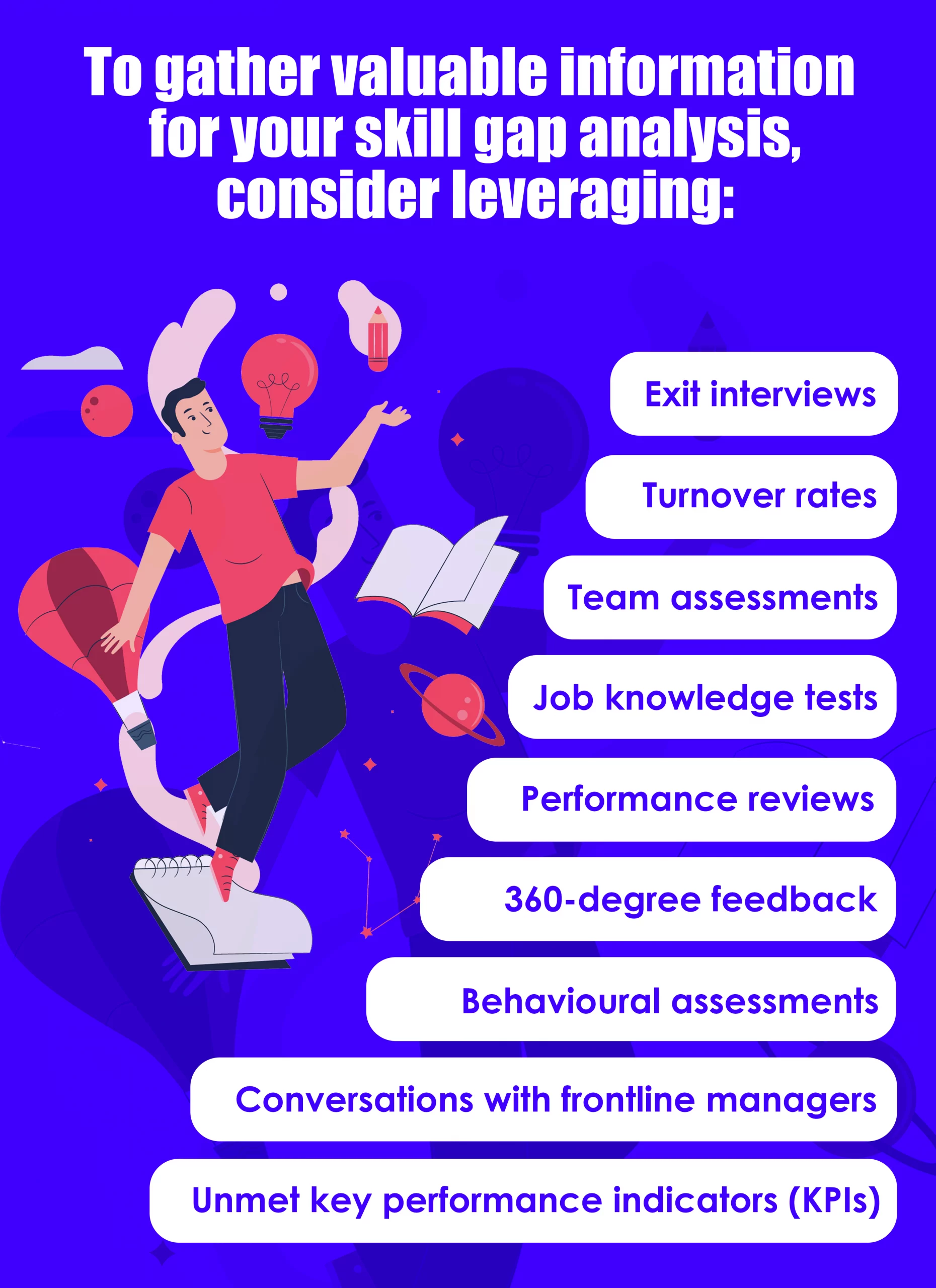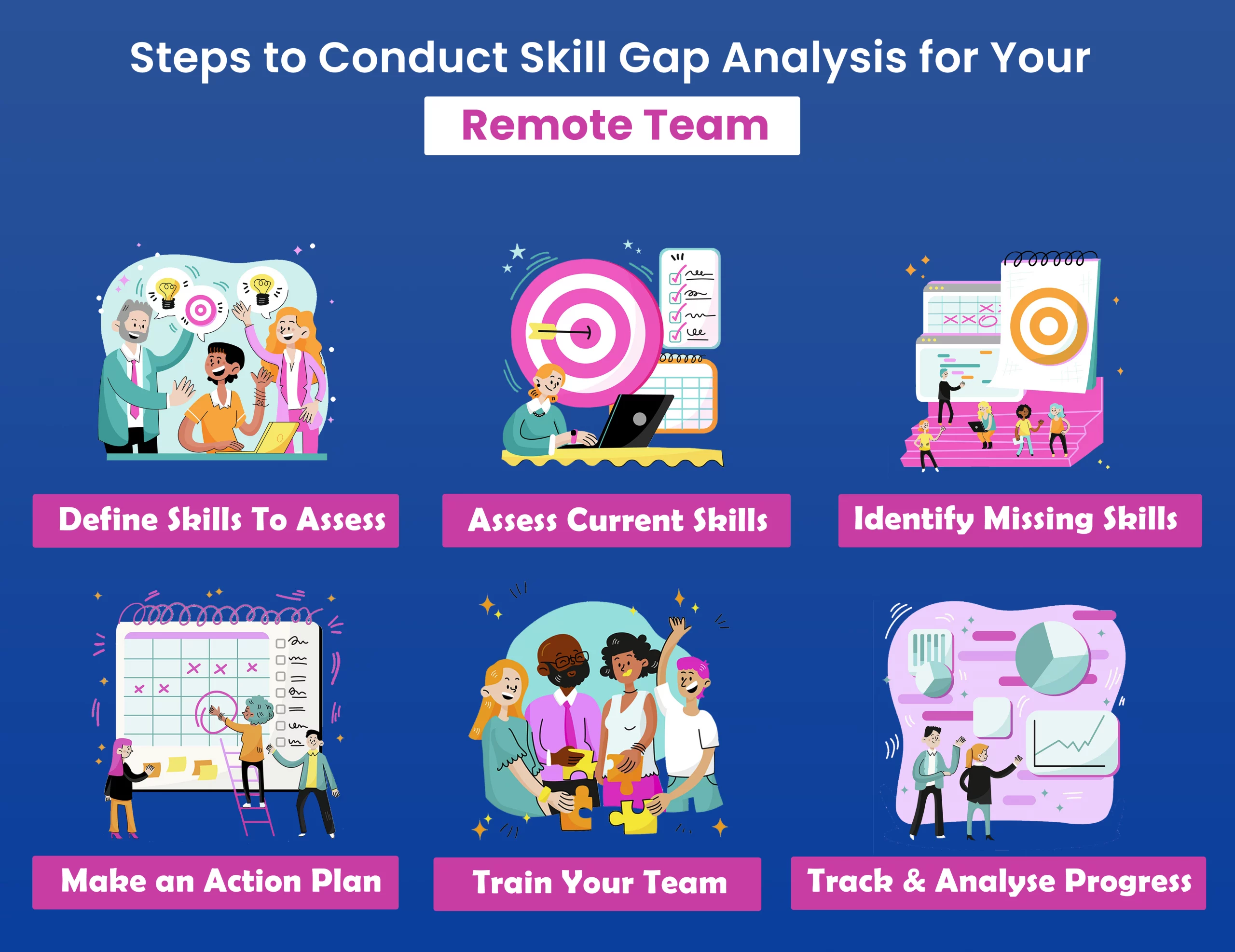Table of content
With remote work becoming the new norm, it’s crucial to ensure your team has the right skills to excel. Skill gap analysis helps you figure out where there are knowledge and proficiency gaps within your team members. By doing so, you can create targeted training programs to bridge those gaps and boost overall productivity.Whether you’re an entrepreneur, a team leader, or an HR professional, this blog will provide you with practical strategies and tools to conduct a skill gap analysis for remote teams effectively. We’ll explore how to evaluate existing skills, identify areas for improvement, and develop training plans tailored to your remote team’s needs.
What is Skill Gap Analysis?
Skill Gap Analysis is a powerful and structured approach to uncovering the missing puzzle pieces in an individual or team’s skill set. By identifying these gaps, you gain valuable insights on how to bridge them effectively. It revolves around aligning your organization’s strategic goals with the talents required to achieve them, while also pinpointing the specific skills that are currently lacking.But the benefits don’t stop there. It goes beyond informing hiring decisions. It also serves as a compass for guiding management approaches. Armed with the information obtained from this process, you can identify areas for improvement at the team level, making it easier to address training or mentoring shortfalls.Once you have identified the skill gaps within your remote team, it’s time to take action. Platforms like Supersourcing, Upwork, and RemoteBase offer a wealth of resources for engaging independent professionals who can complement your team’s capabilities. Whether you need technical expertise or a top-notch podcasting crew, these platforms can help you build a remote workforce that thrives.
How to Conduct A Skill Gap Analysis?
Define the Skills to Measure
Before diving into skill gap analysis, it’s crucial to establish a clear understanding of which skills you want to evaluate. This will depend on the goal of your analysis. Are you looking to assess the overall performance of a team or department? Or perhaps you want to gauge how well employees are performing in specific areas such as collaboration or leadership?When selecting skills, ensure they are relevant to employees’ current roles and future career plans. For instance, evaluating junior employees on leadership skills may not be appropriate, but assessing their initiative-taking abilities could indicate their potential for future leadership roles. Typically, department heads or managers determine the skills to be measured.Remember, it’s essential to be as specific as possible when defining the skills. Take “communication” as an example—it encompasses various aspects. To make it more precise, consider breaking it down into categories like “communication with internal team members,” “communication with customers,” or “written communication.”To streamline the process and facilitate collaboration, create a list of skills in a tool like Excel. This way, you can easily share it with team managers and other stakeholders involved in the skill gap analysis process.
Assess Current Skills
If you’ve noticed a decline in efficiency or productivity within your workforce, especially after the introduction of new technology, it’s time to develop a skill gap analysis plan. By understanding the current skill set of your employees, you can pinpoint the groups that are facing the greatest challenges.To gather valuable information for your analysis, consider leveraging:
- Turnover rates
- Unmet key performance indicators (KPIs)
- Performance reviews
- Conversations with frontline managers
- Exit interviews
- Team assessments
- Job knowledge tests
- 360-degree feedback
- Behavioural assessments
Once you have gathered this data, it’s time to create a comprehensive list of existing skills. An Excel spreadsheet can serve as a useful tool. Each column should include the names of employees, their current tasks, relevant skills, and their proficiency levels in those skills.This information allows you to categorise individuals as beginners, proficient, or experts in various areas. Beginners require supervision, while experts can supervise others. To ensure the accuracy of your data, consider conducting additional skills assessments to validate these categorizations.For example, when assessing your customer service team, use self-assessments via surveys to gauge individuals’ proficiency with ticket/help desk software, call centre technology, and live chat or social assistance tools. Additionally, quantitative feedback from customer satisfaction surveys can provide insights into behavioural competencies.
Recognize Missing Skills
Now that you have a comprehensive list of existing skills, it’s time to pinpoint the gaps—the skills that individuals and your team as a whole lack. It’s not only about talent availability but also the proficiency level. Having a room full of beginners won’t suffice if expertise is required.Generate a comprehensive report highlighting the missing skills. Identify areas where foundational skills exist but fall short of the desired proficiency level. This will guide your decision-making process when considering whether to hire new talent or invest in training to address the skill gaps.While a simple Excel document can serve as the foundation for your analysis, a robust talent management system can offer enhanced user-friendliness in the long run. By consolidating all the information into a searchable database, you can easily review critical skills for the present and, importantly, anticipate future needs. Identifying future requirements in advance empowers you to stay ahead in talent planning.
Devise a Plan
Identifying these gaps allows you to determine the best approach to address them. While retraining your team is one possibility, it’s often more efficient to seek new professionals who already possess the necessary skills. By considering both options, you can create an action plan that aligns with your goals. Retraining may require time and resources, whereas bringing in experienced professionals can provide immediate expertise. Assess the specific needs of your team and weigh the benefits of each scenario. This way, you can make an informed decision and efficiently close the skill gaps for optimal team performance.
Start Training
Training programs can be a valuable tool to bridge the divide between current skill levels and the desired proficiency. One approach is to provide training in specific skills that you want to strengthen, such as utilising SAP or Excel. By offering the right training opportunities, you can empower your team to acquire the necessary skills.Professional training firms can be enlisted to arrange workshops, training sessions, and seminars for your staff. Additionally, you can explore other avenues to support employee development, including subscriptions to online courses and access to educational materials. Implementing voluntary employee mentorship programs, granting opportunities to attend events and conferences, and facilitating certifications like Project Management Professionals (PMP) or Professional Certified Marketers (PCM) can also contribute to skill enhancement.When it comes to training methods, there are three main forms to consider. Offline training takes place in a traditional classroom setting, either internally with subject-matter experts or by outsourcing expert trainers. Online training has gained popularity, especially in remote work settings, enabling employees to learn at their own pace through eLearning platforms. These platforms often incorporate digital tools like a digital adoption platform (DAP) that provide interactive walkthroughs and track progress. Lastly, mentoring and coaching involve experienced professionals guiding employees on specific job tasks, providing targeted support and knowledge-sharing opportunities.By leveraging these training methods, you can empower your team members, close skill gaps efficiently, and foster ongoing development within your organisation.
Wrapping Up!
In conclusion, conducting a skill gap analysis for remote teams is a vital step in optimising performance and ensuring organisational success. However, it doesn’t end with setting up training programs. Regular check-ins with your teams throughout and after the training are essential to gauge its effectiveness and value.While traditional methods like attendance tracking, completion rates, skill assessments, and feedback interviews provide valuable insights, considering innovative evaluation models such as Kirkpatrick’s model, Phillips ROI model, or Kaufman’s model can offer a deeper understanding of training effectiveness and return on investment.It’s crucial to recognize that skill requirements evolve with technology advancements and changing business landscapes. Conducting a skill gap analysis once is insufficient. To stay ahead and address evolving needs, it is recommended to conduct ongoing analyses, ideally on a 3-5 year cycle.By continuously assessing and addressing skill gaps, organisations can foster continuous improvement, adapt to changing demands, and empower remote teams to thrive in the dynamic work environment. Embracing this proactive approach to skill development will contribute to long-term success and maintain a competitive edge in today’s ever-changing world.Supersourcing is the ultimate platform for hiring remote talent to bridge the skill gap in your team. Connect with us to find and hire expert remote developers effortlessly who possess the skills you need.









